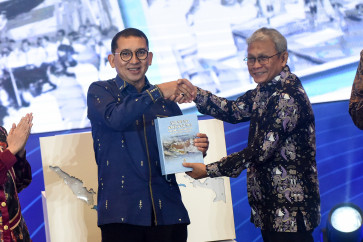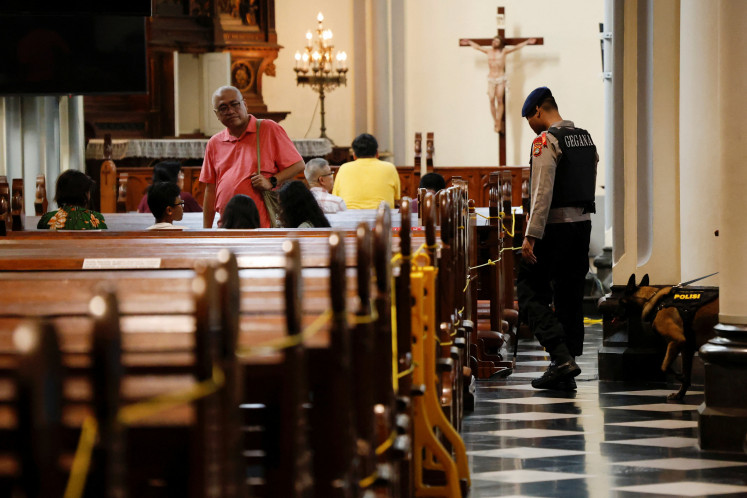Popular Reads
Top Results
Can't find what you're looking for?
View all search resultsPopular Reads
Top Results
Can't find what you're looking for?
View all search resultsASEAN's Indo-Pacific 'can reduce friction'
One of the roles of the newly launched ASEAN Outlook on the Indo-Pacific is to reduce frictions between members and partner countries, as well as tendencies to establish potential "new blocks" among them intended to contain each other’s actions, an Indonesian Foreign Ministry official has said
Change text size
Gift Premium Articles
to Anyone
O
ne of the roles of the newly launched ASEAN Outlook on the Indo-Pacific is to reduce frictions between members and partner countries, as well as tendencies to establish potential "new blocks" among them intended to contain each other’s actions, an Indonesian Foreign Ministry official has said.
“With the outlook in place, there should not be a cooperation or [new alliances] that intend to contain a particular country,” said Siswo Pramono, head of the Foreign Ministry’s Policy Analysis and Development Agency on Friday.
Such a concern may arise considering the geopolitical benefits the region has — which is deemed by many international relations experts as a new ground for global competition of influence.
The United States, for example, adopted the so-called free and open Indo-Pacific concept into its national security policy in 2017. The action was later backed by India, Australia and Japan by forming a strategic alliance called the Quad, raising speculation that it was intended to contain China's influence in the region, particularly as China has reportedly been investing in many strategic infrastructure projects in the region.
In this case, ASEAN through its own Indo-Pacific outlook tries to maintain its neutrality amid the competing major powers.
Siswo said the ASEAN members had to comply with the principle of collaboration based on international laws. “ASEAN members are free to cooperate with other parties [outside ASEAN, in Indo-Pacific] but they have to use the document as their baseline and perspective of the cooperation.”
ASEAN and other Indo-Pacific countries, he added, might engage in individual partnerships. However, ASEAN members, in particular, have to keep in mind that the group has its own version of Indo-Pacific cooperation, manifested through the outlook that “controls how ASEAN countries should behave toward one another” and “consolidate with other non-ASEAN countries regarding the issues on the Indo-Pacific”.
Siswo took the example of how Indonesia built its partnership with India that manifested its Indo-Pacific concept through the Security and Growth for All in the Region (SAGAR) framework — India's policy framework focusing on the Indian Ocean.
He said the parameter to be used was still ASEAN’s perspective, but with further assessment on what aspects were accommodating the synergism between such cooperation and what were not.
“That [ASEAN's Indo-Pacific outlook] is our guidance. We will not follow the [aspects] that do not provide synergism.”
Indonesia recently hosted a joint task force preliminary meeting for Aceh-Andaman and Nicobar connectivity, during which Indonesia and India agreed to strengthen trade, investment for connectivity development, as well as cooperation on sustainable development of marine resources, tourism, education and port development.
During his visit to Jakarta last month, India’s External Affairs Minister Subrahmanyam Jaishankar, said India’s SAGAR fit well with Indonesia's Global Maritime Fulcrum, which detailed President Joko "Jokowi" Widodo's vision to capitalize on Indonesia’s geographic position to make the country a center point of Indo-Pacific maritime activities.
The Habibie Center's ASEAN studies program head, Ibrahim Almuttaqi, said the best way to ensure the ASEAN document was used in the way it was intended by Indonesia, as its initiator, was for the country to take the lead again by demonstrating to other ASEAN members what such concrete Indo-Pacific cooperation looks like.
"If the other ASEAN countries see Indonesia entering cooperation with other dialogue partners under the umbrella of the ASEAN outlook, I think they will also follow suit."
He said that although he believed there would always be concerns that ASEAN could be divided, the ASEAN unity "is something that should never be taken for granted and so all member-states must continuously work to ensure they remain together."










